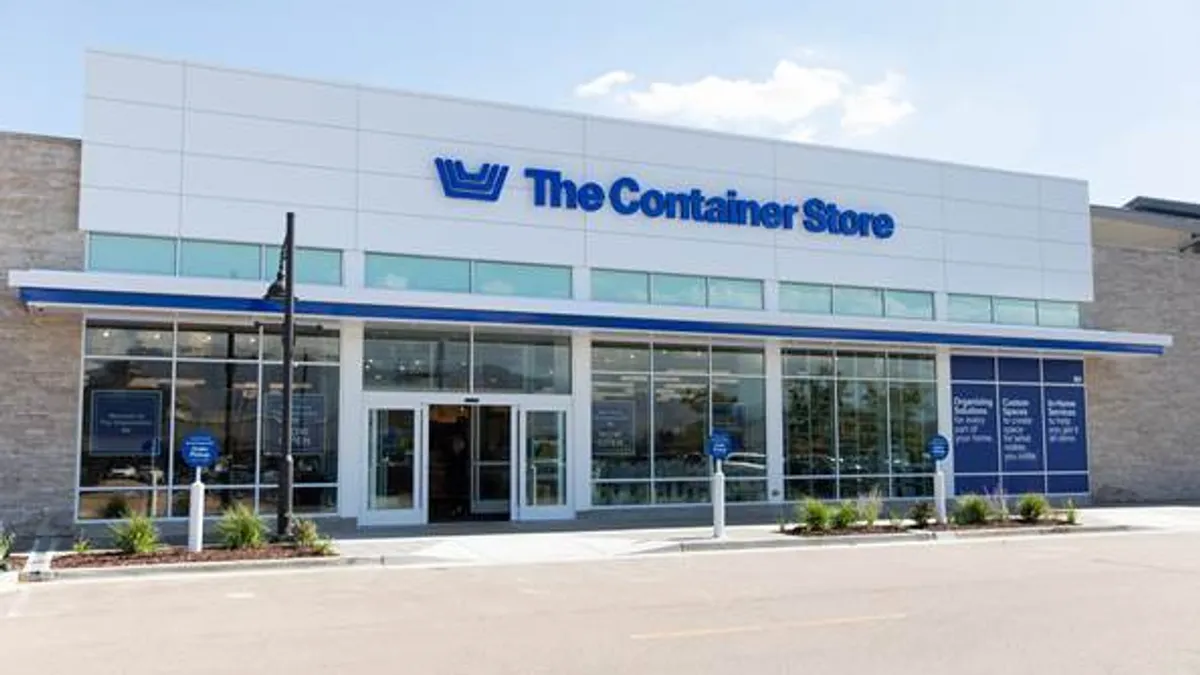In early 2014, Overstock became the first online retailer to accept the crypto currency bitcoin as payment for goods. After interviewing him, tech magazine Wired wrote at the time that then-CEO Patrick Byrne believed that accepting bitcoin payments could "ultimately boost the company's bottom line."
The executive would go on to create a new unit within Overstock dedicated to blockchain, the technology underlying crypto currencies. In the years following, the company's bet on blockchain would lose the company many millions of dollars out of its bottom line.
Byrne left the company in 2019 after a series of disclosures and controversial public remarks that had nothing to do with retail or blockchain. Under a new CEO, company veteran Jonathan Johnson, Overstock refocused around what it was built to do: sell home furnishings and furniture online.
"If you just mind your P's and Q's, [retail] is a business as old as Cain and Abel having a farmers market and a butcher shop," Johnson told Retail Dive in an interview. "If you do it right, you can make money."
The timing was a lucky turn for Overstock. Both e-commerce as a channel and home goods as a category took off as COVID-19 reshaped the world. For fiscal 2020, the company posted its first operating profit for the year since 2016. That was thanks in large part to a more than $1 billion increase in sales to its topline, a 75% increase from the year prior.
The pace of growth hasn't slowed down so far in 2021. First quarter revenue rose 94% year over year to $660 million, with the number of active customers spiking by a similar figure to nearly 10 million.
Retail is once again seen as the future of the company by top management. "We're all about being an online furniture company," Johnson said. As it tries to leave years of losses and controversy behind it, the big question for Overstock is whether it can keep up with digital and omnichannel giants; and whether its sales and profit growth are lasting and stable, or a fortunate and temporary accident of the pandemic.
From e-tailer to blockchain evangelizer
Founded in 1997 near Salt Lake City as "Discounts Direct," Overstock was among the early players in e-commerce. Byrne, the son of a former chairman of the insurance company Geico, acquired the company and renamed it Overstock.com in 1999. That year it made just under $2 million in revenue.
From there Overstock helped pioneer drop shipping, and in 2004 — the year before Amazon launched its Prime membership — Overstock created its "Club O" loyalty program that offered nearly free shipping for members.
Overstock's Medici ventures launched in 2014 with utopian purpose. The stated aim of developing blockchain-based technology was "to democratize capital, eliminate middlemen, and re-humanize commerce," in the company's own words. Elsewhere the company has said the goal is to build the "tech stack for civilization."
By 2017, Byrne was saying publicly that he intended to sell Overstock's retail business — the side of the business generating cash — to focus on blockchain ventures in its Medici unit. By then, both the retail and blockchain sides of Overstock were losing money. The company posted a $111.9 million net loss in 2017 and a $217.6 million loss the following year, when Byrne's plans to sell the retail business took form and urgency.
Byrne would leave the company before his vision of selling the retail business and spearheading a blockchain revolution through Medici was anywhere close to realization.
His resignation followed the disclosure of a romantic relationship with a woman convicted and jailed with acting as a foreign agent for Russia, Maria Butina, as well as a cryptic company statement about his involvement with federal investigations into 2016 election interference from Russia. On his blog, Byrne suggested the company would have lost his corporate insurance with him in charge following the ensuing controversy.
Since he left the company, much of Byrne's blog has been taken up with extended narratives on those subjects, as well as other political conspiracy theories, including around the 2020 election. (Byrne did not respond to an interview request sent to a press email address tied to his blog.)
A retail business 'ignored'
Johnson had run Medici before taking over as CEO in 2019. He also served as president of the company from 2008 to 2013, giving him a deep familiarity with the retail business as well.
"When I came back, I could see that it had just been ignored," Johnson says of his thoughts on returning to oversee the retail division as CEO. "We had one business losing money, the other business spending money," Johnson said of Medici and the retail divisions. "That's a ticket to the poorhouse."
As Johnson tells it, he worked to narrow the company's focus. "In 2019, the company had 27 strategic initiatives," he said. "And 27 strategic initiatives is like having zero strategic initiatives." He worked to recenter the company on the nuts and bolts of online retailing, like pricing, product findability, and customer adoption of the company's mobile app, the latter of which is a priority for 2021.
Johnson also had a different management approach from his predecessor. "One thing I realized was, the executives were looking down at the end of the table where I was to make a decision," Johnson said. "We'd had a founder-CEO for two decades, who … made all the decisions."
Instead of issuing commands from the top, he tried to "make really clear where we want to go and now let people figure out how to get there," Johnson said. "People love to be empowered. They love to have control over what they're doing and work harder when they feel like they can."
Learning to buy furniture online
Months into Johnson's tenure as CEO, the world changed dramatically: COVID-19, stay-at-home orders, store closures and dizzying e-commerce growth. That growth applied to the home category as well, as consumers took to the internet to furnish home offices and redecorate the places they were indefinitely stuck in.
Johnson is confident that both the expanded interest in home goods and the shift to online purchases of home products is here to stay. "At the beginning of 2020, 23% of purchases in the home furnishings space in the U.S. were online. Now it's 35%," he said. "We think that sticks, just like two decades ago people figured out how to buy books online, and a decade ago it was clothes."
Some analysts agree. "The convenience of getting home merchandise online — there's some stickiness to that," D.A. Davidson analyst Tom Forte said in an interview. "Shopping for home goods in physical stores is a pain in the neck. You don't walk in and out of Ikea in two minutes. There are a lot of reasons why home e-commerce is having its moment."
Forte points to the focus on homes since the pandemic, movement to the suburbs and multiple rounds of economic stimulus, as well as how online players, such as Purple, "taught" consumers to buy furniture online "sight unseen."
Others are skeptical that the boom is sustainable. Neil Saunders, managing director with GlobalData, said he believes e-commerce is on a new trajectory since the pandemic began but added, "The thing I find more concerning is not so much where products are sold but how many products people need to buy."
Home goods and even retail broadly speaking had a surprisingly good 2020 (with notable category exceptions like apparel). Transfers in spending from experiential purchases like tourism and eating out helped lift purchases of goods, including home products, as consumers outfitted remote offices and classrooms.
"That definitely cannot continue. The levels of buying are artificial," Saunders said. "People have upgraded their desks. They're not going to go out and buy more of those things." Saunders also noted that spending is likely to swing back to experiences as vaccinations increase. "Consumers are thoroughly sick of being at home," he said. "As soon as the economy opens up proper, they will take advantage of doing other things."
For his part, Johnson thinks home spending will remain elevated, as consumers furnish their yard spaces and prepare their homes for indoor entertaining once again as the pandemic subsides in force.
Heavy home goods hitters
Overstock of course isn't the only online player in home goods. Pulling from outside data and analysis, the company noted in April that it had surpassed Target to become the No. 4 player among online home furnishing retailers. Ahead of it, in order, were Amazon, Wayfair and Walmart.
Of the top five online players, only Overstock and Wayfair specialize in the category. Wayfair is considerably larger, with more than $14 billion in sales for 2020 to Overstock's $2.5 billion.
Wayfair has become a force in home goods, one of several competitive factors that sparked the bankruptcy and liquidation of Pier 1. Saunders points out that Wayfair has a wider SKU count and broader price point range than Overstock, and has wider reach.
"Awareness is much higher with Wayfair than Overstock," Saunders said. "There are probably a lot of people who might not have heard of Overstock." However, there is financial pressure for Wayfair built into that awareness. "Wayfair spends an absolute fortune on advertising and customer acquisition," Saunders added.
It's expensive to market and acquire customers online. One of the unsung virtues of brick and mortar is the continual marketing benefit of a storefront. That may be one reason for Overstock to seek out some kind of physical presence at some point.
"You don't necessarily need physical locations to grow sales. Amazon and Wayfair demonstrated that," Saunders said. "That said, you may need a physical presence to generate brand awareness. Because consumers tend to have big periods where they are not buying furniture, retailers can drop off the radar. There is a lot of marketing spend [in home goods], and a lot of that spend is wasted."
Stores can also be pickup and return channels, as well as showrooms. Asked if he sees a need for physical consumer-facing space at any point, Johnson said, "Omnichannel is ultimately where the market is."
"Whether it's a strategic partnership, like Kohl's and Amazon, where we find the right person to do the showrooming and take returns, or whether it's something more — we look at that kind of thing all the time," Johnson added. "I think that's in the future, but we're not racing to the wrong place. We're going to be thoughtful."
'His own vision'
As for Medici, it has been converted from company subsidiary to a venture capital fund.
In late April, Overstock closed on a deal that turned over direct management of the fund to Pelion Venture Partners, a venture capital firm. Johnson said the goal for the fund is the same as with other venture capital funds: to make exits. That frees up Overstock to focus on online retail. Johnson said that the company used to have 40 developers at work on Medici projects. Not anymore.
The Pelion deal also represents a complete reversal from the Byrne era. Instead of trying to market the retail business, Overstock is now hoping to sell off its blockchain projects so it can focus on its future in retail.
"Patrick Byrne had a lot of vision and thoughtful ideas, but Jonathan has proven he can have his own vision and is a much better executor, without disrespecting Patrick too much," Forte said.
However, Forte added that if the right buyer came along — such as a Target, Costco or T.J. Maxx — "I'm of belief that if one of those companies came to Jonathan and said, 'Hey, this is an offer you can't refuse,' he, being a good businessman, would sell the asset."




















